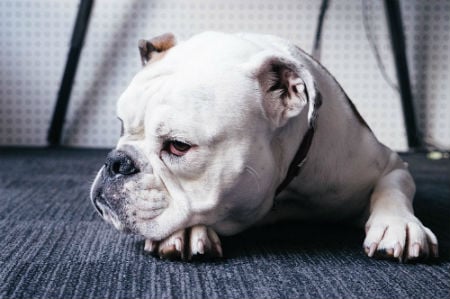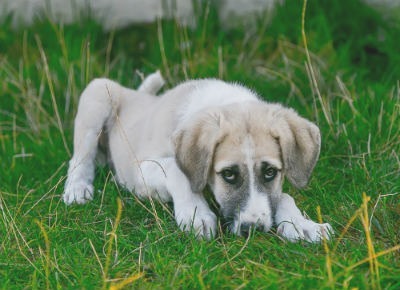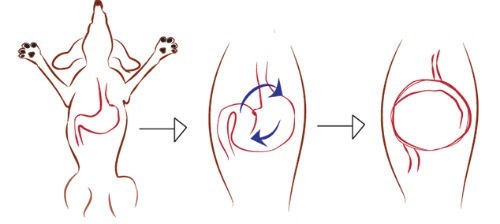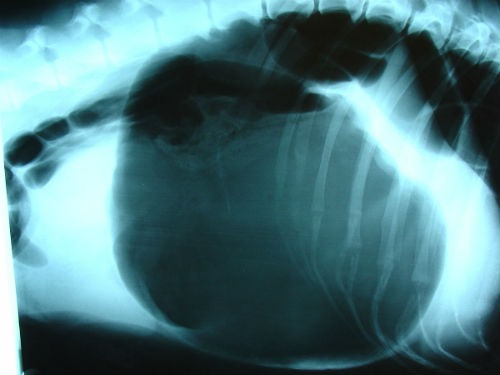Gastric torsion in dogs: causes, symptoms and recommendations

What is gastric torsion?
Gastric torsion, whose full name is Gastric dilatation-cross syndrome, it is an acute disease that occurs in many groups of animals, including man. In dogs, more prone breeds to suffer gastric torsion They are the big, deep chest, guy boxer, great Danish, German shepherd, giant schnauzer, dobermanBulldog, Dalmatian, among others, although smaller breeds may also suffer if they are not provided with adequate nutrition.
What happens during gastric torsion in dogs?

Causes of gastric torsion in dogs: some hypotheses
The Causes that cause gastric torsion in dogs. One of the proposed hypotheses is the inability of the ligaments that support the stomach to hold it properly due to the great dilation suffered by the accumulation of gases. However, it is believed that too It can be related to some abnormality in stomach movements and even have some hereditary component. Its appearance has been associated with copious intakes of food at once, as well as with eating very fast, drinking a lot of water and eating immediately before or after the performance of physical exercise. The development of stressful situations for the dog during the time of its food has also been mentioned.Symptoms of gastric torsion in dogs
Initial symptoms
The first symptom that can be evidenced is inflammation or stomach swell, what should attract your attention and be a reason for careful observation of the dog, as it can move quickly until gastric torsion occurs. Given these first symptoms, it is important to take the precautions of the case, which can include the visit to the veterinarian, since the early detection will be the one that allows the proper and timely treatment that your dog's life can save.
Associated symptoms
In addition to inflammation or swelling, Your dog can Start presenting other symptoms associated with the internal process that is being developed:- It produces many gases or belching.
- He is restless and complains.
- Suffers from abdominal spasms that cause nausea And desire to vomit, but he is not able to do it; Sparkling saliva boot.
- The abdominal cavity sounds like a drum if it hits gently on it.
- You can present Difficulty breathing.
- You will see what something happens because it will be depressed, weak and without appetite.

Gastric torsion treatment of dogs
Initial treatment
The main treatment is immediate attention from your dog by the veterinarian Who will proceed with the diagnosis, for which it can be helped with an radiography that will allow you to see how relaxed the stomach is. As soon as possible, it must stabilize it through the supply of intravenous fluids and antibiotics and, if possible, to the emptying of the stomach to reduce the pressure. Once the stabilization of the general state of the dog is achieved and depending on the gravity that torsion has reached, surgical intervention may be necessary for return the stomach and spleen to its natural position and eliminate the parts of intestine that have suffered necrosis. Sometimes, the stomach must be connected directly to the colon to avoid future torsion episodes and should be fixed to the costal wall to avoid the risk of future torsion.Postoperative treatment
In addition to all the care that must be followed in emergency treatment and the possible surgical intervention, you must take special care with the subsequent treatment due to the risks of infection that may occur that they can derive in peritonitis. However, one of the biggest postoperative complications It can be presented by the restart of blood irrigation in affected tissues. When normal blood circulation is restored, cardiac arrhythmias that must be treated with the indicated drugs can occur.
Recommendations
For prevent your dog from suffering a gastric torsion, the main recommendation is to control the amount of food you consume in each meal. It is preferable that meals fractions and establish a more or less fixed schedule for them to perform them. It is also recommended to control water intake after each meal and avoid exercise one hour before and, at least three hours after eating. Help also maintain a relaxed environment for the moment you eat. Remember that these preventive measures will not necessarily prevent your dog from suffering gastric torsion, so you should always be attentive to your condition and go immediately to the veterinarian in case of any suspicion. [embed] https://www.youtube.com/watch?v=kaxbf4u-jrg[/embed]Share
